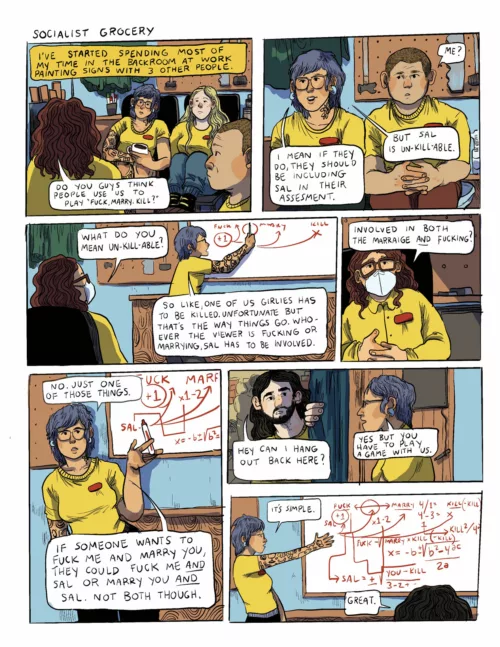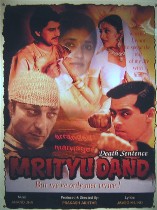 The pointed art in “Love Triangles,” nearly slip-slides out of your hand before you even notice there’s some content in the bubble bath.
The pointed art in “Love Triangles,” nearly slip-slides out of your hand before you even notice there’s some content in the bubble bath.
The small group show at the Asian Arts Initiative satirizes Asian soap operas and Bollywood movies as well as the images of Asians here and beyond. It features the work of four Asian-American artists from out of town as well as a collaborative wall installation by some local Asian-American artists.
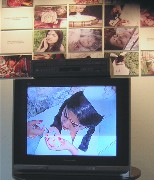 Two of the artists are showing videos inspired by soaps and Bollywood, and of them, Swati Khurana’s videos were the more complex. She mocks the overheated, stereotyped roles of women in a loopy technicolor trio, all featuring the same star with thick black hair and lots of makeup. She’s got the lipstick. She’s got the pink cheeks, the black eyes, sometimes the exotic dots. Sometimes she’s dressed in white. Sometimes she’s wearing an Xtreme skirt of three-D flowers. Sometimes she’s an angel. Sometimes she does self-destructive things (see image right with some stills above it). Sometimes she has the vapors. No matter what, though, this beauty’s behavior is ridiculous and pathetic–not unlike the behavior of women in Bollywood films–and often Hollywood films.
Two of the artists are showing videos inspired by soaps and Bollywood, and of them, Swati Khurana’s videos were the more complex. She mocks the overheated, stereotyped roles of women in a loopy technicolor trio, all featuring the same star with thick black hair and lots of makeup. She’s got the lipstick. She’s got the pink cheeks, the black eyes, sometimes the exotic dots. Sometimes she’s dressed in white. Sometimes she’s wearing an Xtreme skirt of three-D flowers. Sometimes she’s an angel. Sometimes she does self-destructive things (see image right with some stills above it). Sometimes she has the vapors. No matter what, though, this beauty’s behavior is ridiculous and pathetic–not unlike the behavior of women in Bollywood films–and often Hollywood films.
Khurana, who lives and works in Brooklyn, has shown in the U.S. (including at White Columns in New York) and in India. She draws in material from East and West in her videos, and comes up with funny, scary views of how the media communicate the roles of women.
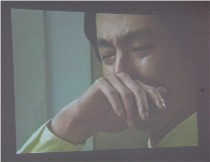 The other video in the show comes from Sung Baik (the only male among the invited four artists). “Melo Me Nelo We” collages clips from Korean soap operas of characters in tears–male and female. Baik, who was born in Korea and now lives in northern New Jersey, plays the one sad, sad joke over and over, in a brief loop. (I’m pretty sure I saw this video before, but I don’t know where). Since I don’t watch soap operas, I don’t really know if American soaps include men weeping, but the Korean soaps do, and that’s what happens when the soap bubbles and smoke get in their eyes. I also don’t know if love always ends with this much moisture in American soaps, or if love ever ends but just goes on struggling from episode to episode. In other words, I’m not sure if this is a cautionary tale specific to Korea or if that’s the way that all soaps operate–and the soap-opera message would be, don’t dip your toes in the salty sea of love or else. Baik’s message is something else entirely–soaps make these people look ridiculous. Is he also saying the weeping is making them look too American? Beats me. I don’t know enough (left, still from “Melo Me Nelo We”).
The other video in the show comes from Sung Baik (the only male among the invited four artists). “Melo Me Nelo We” collages clips from Korean soap operas of characters in tears–male and female. Baik, who was born in Korea and now lives in northern New Jersey, plays the one sad, sad joke over and over, in a brief loop. (I’m pretty sure I saw this video before, but I don’t know where). Since I don’t watch soap operas, I don’t really know if American soaps include men weeping, but the Korean soaps do, and that’s what happens when the soap bubbles and smoke get in their eyes. I also don’t know if love always ends with this much moisture in American soaps, or if love ever ends but just goes on struggling from episode to episode. In other words, I’m not sure if this is a cautionary tale specific to Korea or if that’s the way that all soaps operate–and the soap-opera message would be, don’t dip your toes in the salty sea of love or else. Baik’s message is something else entirely–soaps make these people look ridiculous. Is he also saying the weeping is making them look too American? Beats me. I don’t know enough (left, still from “Melo Me Nelo We”).
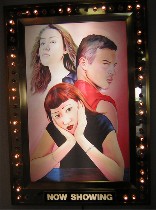 The posters are also fun, some of them framed in rear-lit movie poster marqees, surrounded by brass and flashing lights. Laura Kina, a Chicago artist who’s a friend of Curator Sean Stoops, is the one who uses the marqees. Her work is also what inspired Stoops to put the show together.
The posters are also fun, some of them framed in rear-lit movie poster marqees, surrounded by brass and flashing lights. Laura Kina, a Chicago artist who’s a friend of Curator Sean Stoops, is the one who uses the marqees. Her work is also what inspired Stoops to put the show together.
She makes paintings of groups of young men and women staring out into space, looking bored, looking distressed, backed by vapid, pastel skies. Without any other information, you know there’s romance in the air. And you also know that there are triangles and other complications. Kina makes digi-print-on-vinyl copies of the paintings for the posters and the flashing-light frames. The faces in these pictures are part-Asian, according to Stoops. The way you know this is from the titles, Hapa Soap Opera #1, 2, 3, etc., hapa being a Hawaiian word meaning mixed Asian that’s now used increasingly on the mainland (right above, “Hapa Soap Opera #4”).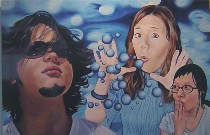 The paintings raise issues about who we’re used to looking at in romantic images in this country. More than one Asian (or part-Asian) face is more than we usually see in a romantic movie poster. Stoops, who is himself a quarter Asian, said Kina is half Japanese, and that he is in one of the paintings.
The paintings raise issues about who we’re used to looking at in romantic images in this country. More than one Asian (or part-Asian) face is more than we usually see in a romantic movie poster. Stoops, who is himself a quarter Asian, said Kina is half Japanese, and that he is in one of the paintings.
The paintings on the most obvious level are about the idealization of what’s really painful personal drama–young love. But they also suggest a way for young people who feel like they don’t fit in the categories of the culture to find their idealized American teen dream (and to reject it at the same time–the paintings cut both ways, which is a nice trick)(left, “Hapa Soap Opera #3”).
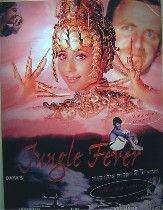 The other posters, by Annu P. Matthew, are Bollywood poster collages with new text, the text being as important here as the images. The values of Indians and Indian-Americans toward women in love and marriage are her subject and she’s pretty funny, taking swipes at the horror-response to mixed-race marriage–or even worse, an affair with a non-Indian. I loved “White Man’s Consort, India’s First 3-D Film.” Arranged marriage also takes a hit from Matthew (see “Mr. Iyudand” at the top). Here’s her web page for more(right, “Jungle Fever”).
The other posters, by Annu P. Matthew, are Bollywood poster collages with new text, the text being as important here as the images. The values of Indians and Indian-Americans toward women in love and marriage are her subject and she’s pretty funny, taking swipes at the horror-response to mixed-race marriage–or even worse, an affair with a non-Indian. I loved “White Man’s Consort, India’s First 3-D Film.” Arranged marriage also takes a hit from Matthew (see “Mr. Iyudand” at the top). Here’s her web page for more(right, “Jungle Fever”).
There’s also a group painting on the wall by Rodney Camarce, Rana Sindhikara and Stoops that invokes the layers of hand-painted movie billboards in places in Asia where street paintings are part of the culture and where sometimes the layers bleed through to the surface. The installation has some horror movie titles in the mix–“I married a monster…Asian invasion”–adding to the discussion of Asians as Other in the show. Stoops said it was a work in process, with multiple Asian languages and more layers to be applied.
By the way, the Asian Arts Initiative (downstairs from Vox) will be open for First Friday from 7 to 9, so if you get a chance, before the show goes down the drain, it’s worth a visit.






